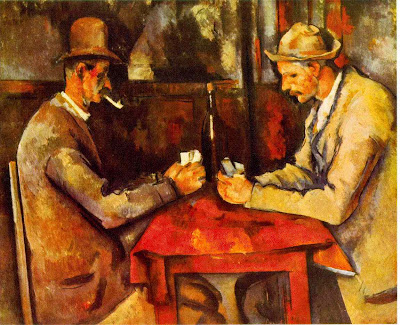The purpose of this project was to "produce one contemporary photo of a classic painting of your choice that includes a human subject/s." We were shown some examples in a fashion art book of taking a traditional painting or work of art and replicating this in a photo, retaining the main idea or emphasis in the contemporary photo. In this way, the original work of art was presented in a tweaked or slightly altered way, but still recognizable for the main emphasis shared shared between the new and altered version. My original plan was to do a contemporary interpretation of either Cezanne's "The Card Players" (1892) or Cezanne's "The Artist's Father" (1866).
 For "The Card Players," I wanted to preserve the idea of what people do in their free time, in this case, I would update the poker set and clothing, but retain the concentration and timelessness of a game of cards.
For "The Card Players," I wanted to preserve the idea of what people do in their free time, in this case, I would update the poker set and clothing, but retain the concentration and timelessness of a game of cards. For the
For theI was hoping to convey for "The Artist's Father" the way that people relax and catch up on news today, in a similar pose, but other surroundings. While this is in a cozy living room chair setting, I would place the reader in an airport with an Ipod in their ears, to show the way people relax today, which is seldom, and on-the-go.
What Really Came Out of It
In between one bad shoot and when I was planning to reshoot digitally, I went to Tanzania on the school service trip. There we were responsible for helping to build a classroom for Kirima Secondary School near Moshi for five days followed by a two day camping trip and a safari. I got a book full of portraits by Steve McCurry from around the world, and was inspired by this to get some portraits from the trip. We visited a Masai village near the Ngorogoro Crater, where I met the Masai warrior from my final print for the project. As we were walking away from the village, this man was walking parallel to us at some distance leading some cows with a staff. He motioned for me to take a photo of him with his cows, pointing to them as if to say "include them!" Considering what we had just learned about the importance of cows to Masai culture - that cows were a measure of wealth, as they provided on behalf of the chief the milk and meat for the village, thus dictating how many wives a man could have (the more cows, the more wives and children the chief can support. In this particular boma, the chief had four wives and 25 children. ) - I could see why this warrior wanted his picture taken with his cows - he was proud. After I took that shot, he came over, all smiles, and asked me to take another one. I was happy with this, since I was hoping to get portrait shots, and the background of hills and blue sky was perfect - not to mention he was all decked out in Masai clothing and beads. I don't think that I was as happy as he was though. As soon as I positioned the camera to take a photo, his smile disappeared, his hand went up with his staff, and he got a serious photo-taking face on. Immediately after, he demanded to see what it looked like, I showed him and he was pleased.
We were talking later in the car about how interesting the culture was, the polgamy, the norm for girls to be married around 12-14, the government requirement that the children attend school, things like that, especially the cow emphasis, and I thought again about how much that man wanted to be photographed. While most were hesitant to have pictures taken, besides the kids, he demanded it. I thought of the desire for people to leave their stamp and their legacy in the form of a portrait, and I was reminded of how monarchs used to have their portraits painted in those pompous triumphant poses just to leave behind a memory of themselves. Because they were proud. This was little different. this experienced warrior (for each battle, warriors cut a piece of their ear, which this warrior has) was determined to show his "kingdom" and what he had achieved in the form of a lasting picture. He stopped smiling for the picture to have a serious, dominant presence, much like monarchs posed all tall and looking off into the distance all noble-like.
The portrait that I found to be particularly representative of this habit of monarchs having themselves painted is one of Willem I Prince of Orange of the Netherlands. He has a royal red robe, and a very strong and confident, almost showy, stance.
 The portrait of the Masai warrior from Tanzania shows similar characteristics, though far removed by time and cultural differences. He is also confident and dominating. the red robe is a nice echo, as is the shared characteristic of the need to leave a mark showing their achievements and what they own, what they are proud of.
The portrait of the Masai warrior from Tanzania shows similar characteristics, though far removed by time and cultural differences. He is also confident and dominating. the red robe is a nice echo, as is the shared characteristic of the need to leave a mark showing their achievements and what they own, what they are proud of.


No comments:
Post a Comment